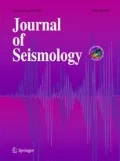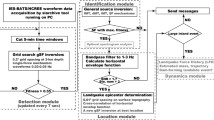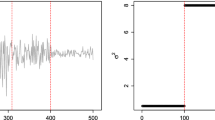Abstract
We analyze the location of earthquakes in near regional networks using complete seismic records. The method is based on the source scanning algorithm (SSA) of Kao and Shan (2004), but similarly to Grigoli et al. (2013), seismograms are substituted by a P-wave picker trace. The picker traces in a network are repeatedly stacked using grid of trial source positions, and hypocenter is identified with the point providing the best stack (the largest brightness). The first innovation of this paper is a new picker, measuring the ratio of the summed absolute values of seismogram in the right and left part of a moving time window, the RPA/LPA picker. The brightness maps based on this picker are clearer than those based on the STA/LTA picker. The second innovation is a simple theoretical model of the brightness maps. It makes it easy to identify how individual stations contribute to form the brightness spot. It is shown on synthetic tests that the performance of the method depends on focal mechanism, progressively improving from normal to reverse and strike-slip events. The method is successfully applied to four events of different mechanisms and depths, recorded at different ranges of epicentral distance by either broad-band sensors or accelerographs. The events have been located close to previously published epicenters. The brightness maps provide an estimate of the relative uncertainty of the (non-linear) location problem. The uncertainty estimate is also applicable without measured arrival times, “without earthquakes”, thus useful when designing or upgrading seismic networks for better location performance.










Similar content being viewed by others
References
Ameri G, Gallovič F, Pacor F (2012) Complexity of the Mw 6.3 2009 L’Aquila (Central Italy) earthquake: 2. Broadband strong-motion modeling. J Geophys Res 117: no. B04308. doi:10.1029/2011JB008729
Bouchon M (1981) A simple method to calculate Green’s functions for elastic layered media. Bull Seism Soc Am 71:959–971
Coutant O (1989) Programme de simulation numérique AXITRA. Res. Report LGIT, Grenoble, France
Evangelidis CP, Kao H (2014) High-frequency source imaging of the October 23, 2011 Van (Eastern Turkey) earthquake by back-projection of strong motion waveforms. Geophys J Int 196:1060–1072. doi:10.1093/gji/ggt437
Fojtíková L, Kristeková M, Málek J, Zahradník J, Progseis Ltd. (2013) Uncertainty in locations and moment tensors of micro-earthquakes in Little Carpathians improved by new stations. 4th Annual Meeting of project AIM (Advanced Industrial Microseismic Monitoring). September, 11–14, 2013, Třešť castle, Czech Republic, http://www.ig.cas.cz/sites/default/files/Fojtikova_et_al_AIM2013.pdf (last accessed in November 2014)
Fojtíková L, Zahradník J (2014) A new strategy for weak events in sparse networks: the first-motion polarity solutions constrained by single-station waveform inversion. Seism Res Lett 85:1265–1274. doi:10.1785/0220140072
Gallovič F, Zahradník J (2012) Complexity of the M 6.3 2009 L’Aquila (central Italy) earthquake: 1. Multiple finite-extent source inversion. J Geophys Res 117: no. B04307. doi:10.1029/2011JB008709
Gallovič F, Zahradník J, Křížová D, Plicka V, Sokos E, Serpetsidaki A, Tselentis GA (2008) From earthquake centroid to spatial-temporal rupture evolution: Mw 6.3 Movri Mountain earthquake, June 8, Greece. Geophys Res Lett 36, L21310. doi:10.1029/2009GL040283
Gallovič F, Ameri G, Zahradník J, Janský J, Plicka V, Sokos E, Askan A, Pakzad M (2013) Fault process and broadband ground-motion simulations of the23 October 2011 Van (eastern Turkey) earthquake. Bull Seism Soc Am 103:3164–3178. doi:10.1785/0120130044
Grigoli F, Cesca S, Vassallo M, Dahm T (2013) Automated seismic event location by travel-time stacking: an application to mining induced seismicity. Seism Res Lett 84:666–677. doi:10.1785/0220120191
Grigoli F, Cesca S, Amoroso O, Emolo A, Zollo A, Dahm T (2014) Automated seismic event location by waveform coherence analysis. Geophys J Int 196:1742–1753. doi:10.1093/gji/ggt477
Janský J, Novotný O, Plicka V, Zahradník J, Sokos E (2012) Earthquake location from P-arrivals only: problems and some solutions. Stud Geophys Geod 56:553–566. doi:10.1007/s11200-011-9036-2
Kao H, Shan SJ (2004) The source-scanning algorithm: mapping the distribution of seismic sources in time and space. Geophys J Int 157:589–594
Kao H, Shan SJ (2007) Rapid identification of earthquake rupture plane using source-scanning algorithm. Geophys J Int 168:1011–1020
Kao H, Shan SJ, Dragert H, Rogers G (2009) Northern Cascadia episodic tremor and slip: A decade of tremor observations from 1997 to 2007. J Geopys Res 114: B00A12. doi:10.1029/2008JBB006046
Kennett BLN, Kerry NJ (1979) Seismic waves in a stratified half space. Geophys J R Astron Soc 57:557–583. doi:10.1111/j.1365-246X.1979.tb06779.x
Langet N, Maggi A, Michelini A, Brenguier F (2014) Continuous kurtosis-based migration for seismic event detection and location, with application to Piton de la Fournaise volcano, La Réunion. Bull Seism Soc Am 104:229–246. doi:10.1785/0120130107
Latorre D, Virieux J, Monfret T, Monteiller V, Vanorio T, Got JL, Lyon-Caen H (2004) A new seismic tomography of Aigion area (Gulf of Corinth, Greece) from the 1991 data set. Geophys J Int 159:1013–1031
Liao Y, Kao H, Rosenberger A, Hsu S, Huang B (2012) Delineating complex spatiotemporal distribution of earthquake aftershocks: An improved source-scanning algorithm. Geophys J Int 189:1753–1770. doi:10.1111/j.1365-246X.2012.05457.x
Lomax A, Virieux J, Volant P, Berge C (2000) Probabilistic earthquake location in 3D and layered models: introduction of a Metropolis-Gibbs method and comparison with linear locations. In: Thurber CH, Rabinowitz N (eds) Advances in seismic event location. Kluwer, Amsterdam, pp 101–134
Novotný O, Zahradník J, Tselentis GA (2001) Northwestern Turkey earthquakes and the structure inferred from surface waves observed in Western Greece. Bull Seism Soc Am 91:875–879
Quintero R, Zahradník J, Sokos E (2014) Near-regional CMT and multiple-point source solution of the September 5, 2012, Nicoya, Costa Rica Mw 7.6 (GCMT) earthquake. J South Am Earth Sci 55:155–165. doi:10.1016/j.jsames.2014.07.009
Rigo A, Lyon-Caen H, Armijo R, Deschamps A, Hatzfeld D, Makropoulos K, Papadimitriou P, Kassaras I (1996) A microseismic study in the western part of the Gulf of Corinth (Greece): implications for large scale normal faulting mechanisms. Geophys J Int 126:663–688
Sokos E, Zahradník J (2008) ISOLA a Fortran code and a Matlab GUI to perform multiple-point source inversion of seismic data. Compt Geosci 34:967–977. doi:10.1016/j.cageo.2007.07.005
Sokos E, Zahradník J (2013) Evaluating centroid moment tensor uncertainty in the new version of ISOLA software. Seism Res Lett 84: doi:10.1785/0220130002
Sokos E, Zahradník J, Kiratzi A, Janský J, Gallovič F, Novotný O, Kostelecký J, Serpetsidaki A, Tselentis GA (2012) The January 2010 Efpalio earthquake sequence in the western Corinth Gulf (Greece). Tectonophysics 530–531:299–309. doi:10.1016/j.tecto.2012.01.005
Zahradník J, Custódio S (2012) Moment tensor resolvability: application to southwest Iberia. Bull Seism Soc Am 102:1235–1254. doi:10.1785/0120110216
Zahradník J, Sokos E (2014) The Mw 7.1 Van, Eastern Turkey, earthquake 2011—two-point source modeling by iterative deconvolution and non-negative least squares. Geophys J Int 196:522–538. doi:10.1093/gji/ggt386
Acknowledgment
For events 1 and 2, waveform data of the Hellenic Unified Seismic Network were used, in which 12 stations are owned by the Charles University in Prague and co-operated by the University of Patras. Event 3 was processed with open-access accelerometric data available from the Italian Strong Motion Network (ITACA). For event 4, we used the accelerograms of the National Strong Motion Network of Turkey (TR-KYH) available on Internet shortly after the earthquake. Constructive comments of Dr. C. Evangelidis and an anonymous reviewer are highly appreciated. Financial support was obtained from the Czech Republic grants: GAČR 210/11/0854, MSM 0021620860 and CzechGeo/EPOS LM2010008.
Author information
Authors and Affiliations
Corresponding author
Electronic supplementary material
Below is the link to the electronic supplementary material.
Supplement S1
Real data, Event 1. The animation shows the set of snapshots of the RPA/LPA brightness (map view) calculated for varying trial origin time, step of 0.1 s. The optimum origin time is for snapshot no. 12. (GIF 615 kb)
Supplement S2
Same as Supplement S1, but for Event 2. The optimum origin time is for snapshot no. 13. (GIF 593 kb)
Supplement S3
Same as Supplement S1, but for Event 3. The optimum origin time is for snapshot no. 15. Red rectangle shows the fault plane after Gallovič and Zahradník, 2012. (GIF 650 kb)
Supplement S4
Same as Supplement S1, but for Event 4. The optimum origin time is for snapshot no. 12. Red rectangle shows the fault plane after Gallovič et al., 2013. (GIF 658 kb)
Rights and permissions
About this article
Cite this article
Zahradník, J., Janský, J. & Plicka, V. Analysis of the source scanning algorithm with a new P-wave picker. J Seismol 19, 423–441 (2015). https://doi.org/10.1007/s10950-014-9475-7
Received:
Accepted:
Published:
Issue Date:
DOI: https://doi.org/10.1007/s10950-014-9475-7




